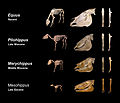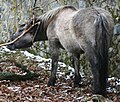Portal:Horses
The Horses PortalThe horse (Equus ferus caballus) is a domesticated, one-toed, hoofed mammal. It belongs to the taxonomic family Equidae and is one of two extant subspecies of Equus ferus. The horse has evolved over the past 45 to 55 million years from a small multi-toed creature, close to Eohippus, into the large, single-toed animal of today. Humans began domesticating horses around 4000 BCE, and their domestication is believed to have been widespread by 3000 BCE. Horses in the subspecies caballus are domesticated, although some domesticated populations live in the wild as feral horses. These feral populations are not true wild horses, which are horses that never have been domesticated and historically linked to the megafauna category of species. There is an extensive, specialized vocabulary used to describe equine-related concepts, covering everything from anatomy to life stages, size, colors, markings, breeds, locomotion, and behavior. Horses are adapted to run, allowing them to quickly escape predators, and possess a good sense of balance and a strong fight-or-flight response. Related to this need to flee from predators in the wild is an unusual trait: horses are able to sleep both standing up and lying down, with younger horses tending to sleep significantly more than adults. Female horses, called mares, carry their young for approximately 11 months and a young horse, called a foal, can stand and run shortly following birth. Most domesticated horses begin training under a saddle or in a harness between the ages of two and four. They reach full adult development by age five, and have an average lifespan of between 25 and 30 years. Horse breeds are loosely divided into three categories based on general temperament: spirited "hot bloods" with speed and endurance; "cold bloods", such as draft horses and some ponies, suitable for slow, heavy work; and "warmbloods", developed from crosses between hot bloods and cold bloods, often focusing on creating breeds for specific riding purposes, particularly in Europe. There are more than 300 breeds of horse in the world today, developed for many different uses. (Full article...) Entries here consist of Good and Featured articles, which meet a core set of high editorial standards.
 Equine nutrition is the feeding of horses, ponies, mules, donkeys, and other equines. Correct and balanced nutrition is a critical component of proper horse care. Horses are non-ruminant herbivores of a type known as a "hindgut fermenter." Horses have only one stomach, as do humans. However, unlike humans, they also need to digest plant fiber (largely cellulose) that comes from grass or hay. Ruminants like cattle are foregut fermenters, and digest fiber in plant matter by use of a multi-chambered stomach, whereas horses use microbial fermentation in a part of the digestive system known as the cecum (or caecum) to break down the cellulose. (Full article...)Selected image Dun horses at Erlebnispark Tripsdrill, Germany Latest updates
More did you know?
Related portalsEntries here consist of Good and Featured articles, which meet a core set of high editorial standards.
The Haflinger, also known as the Avelignese, is a breed of horse developed in Austria and northern Italy (namely Hafling in South Tyrol region) during the late 19th century. Haflinger horses are relatively small, are always chestnut with flaxen mane and tail, have distinctive gaits described as energetic but smooth, and are well-muscled yet elegant. The breed traces its ancestry to the Middle Ages; several theories for its origin exist. Haflingers, developed for use in mountainous terrain, are known for their hardiness. Their current conformation and appearance are the result of infusions of bloodlines from Arabian and various European breeds into the original native Tyrolean ponies. The foundation sire, 249 Folie, was born in 1874; by 1904, the first breeders' cooperative was formed. All Haflingers can trace their lineage back to Folie through one of seven bloodlines. World Wars I and II, as well as the Great Depression, had a detrimental effect on the breed, and lower-quality animals were used at times to save the breed from extinction. During World War II, breeders focused on horses that were shorter and more draft-like, favored by the military for use as packhorses. The emphasis after the war shifted toward animals of increased refinement and height. In the postwar era, the Haflinger was indiscriminately crossed with other breeds and some observers feared the breed was in renewed danger of extinction. However, starting in 1946, breeders focused on producing purebred Haflingers and a closed stud book was created. Interest in the breed increased in other countries, and between 1950 and 1974, the population grew, even while the overall European horse population decreased. Population numbers continued to increase steadily, and as of 2005, almost 250,000 Haflingers existed worldwide. Breeding farms are in several countries, although most of the breeding stock still comes from Austria. In 2003, a Haflinger became the first horse to be cloned, resulting in a filly named Prometea. (Full article...)Did you know (auto-generated)
General imagesThe following are images from various horse-related articles on Wikipedia.
TopicsHorse • Pony • Asinus • Equus (genus) • Equidae • Zebra • Glossary of equestrian terms • List of horse breeds • Evolution of the horse • Domestication of the horse • Horse care • Stable • Horse training • Equestrianism • Horse tack • Saddle • Equine nutrition • Equine anatomy • Equine conformation • Equine coat color • Equine coat color genetics • Horse markings • Equine vision • Horse hoof • Horseshoe • Horse gait • Horse behavior • Horse breeding • Breed registry • Equine infectious anemia • Horse colic • Lameness • Laminitis • Horse slaughter • Horses in warfare • Arabian horse • Thoroughbred SubcategoriesNew articlesThis list was generated from these rules. Questions and feedback are always welcome! The search is being run daily with the most recent ~14 days of results. Note: Some articles may not be relevant to this project.
Rules | Match log | Results page (for watching) | Last updated: 2024-05-11 20:12 (UTC) Note: The list display can now be customized by each user. See List display personalization for details.
WikiProjectsAssociated WikimediaThe following Wikimedia Foundation sister projects provide more on this subject:
Discover Wikipedia using portals |



























































